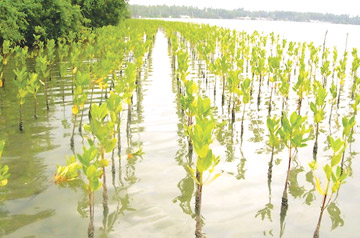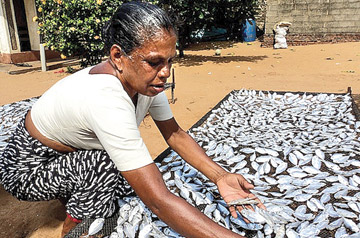From residents to rangers
Local communities take the lead in mangrove
conservation:
by Amantha Perera
Weekends and public holidays are deadly for one of Sri Lanka’s most
delicate ecosystems – that is when the island’s 8,815 hectares of
mangroves come under threat.
 |
|
Young mangrove plants
tended by women beneficiaries from the Small Fishers Federation
have helped the Puttalam Lagoon regain some of its lost natural
glory. (Credit: Amantha Perera/IPS) |
With public officials, forest rangers and NGO workers on holiday, no
one is around to enforce conservation laws designed to protect these
endangered zones. Except the locals, that is.
Residents of Kalpitiya in Puttalam, are no strangers to the wanton
destruction of the area’s natural bounty. Kalpitiya is home to the
largest mangrove block in Sri Lanka, the Puttalam Lagoon, as well as
smaller mangrove systems on the shores of the Chilaw Lagoon.
For centuries, these complex wetlands have protected fisher
communities against storms and sea-surges, while the forests’ underwater
root system has nurtured nurseries and feeding grounds for scores of
aquatic species.
Perhaps more important, in a country still living with the ghosts of
the 2004 Asian Tsunami, mangroves have been found to be a coastline’s
best defence against tidal waves and tsunamis.
Best coastal buffer
Many poor fisher families in western Sri Lanka also rely heavily on
mangroves for sustenance, with generation after generation deriving
protein sources from the rich waters or sustainably harvesting the
forests’ many by-products.
But in Sri Lanka today, as elsewhere in the world, mangroves face a
range of risks. The United Nations Environment Programme (UNEP) says
that the unique ecosystems, capable of storing up to 1,000 tonnes of
carbon per hectare in their biomass, are being felled at three to five
times the rate of other forests.
Over a quarter of the world’s mangrove cover has already been
irrevocably destroyed, driven by aquaculture, agriculture, unplanned and
unsustainable coastal development and over-use of resources.
On the west coast of Sri Lanka, despite government’s pledges to
protect the country’s remaining forests, the covert clearing of
mangroves continues – albeit at a slower rate than in the past.
 |
|
Douglas Tissera
(Credit: Amantha Perera/IPS) |
But a small army of land defenders, newly formed and highly
dedicated, is promising to turn this tide.
Residents as rangers
They call him the ‘Mangrove Master,’ but his real name is Douglas
Tissera. A fisherman turned vigilante, he is the director for
conservation at the Small Fisheries Foundation of Lanka (Sudeesa) and
spends his days patrolling every nook of the Chilaw Lagoon for signs of
illegal destruction.
Last month, the Sudeesa programme received a massive boost from the
US-based NGO Seacology, to expand its operations island-wide. The Sri
Lankan Government also signed on as a major partner for the five-year,
US$ 3.4 million mangrove protection scheme. The project will use
Sudeesa’s original initiative as a blueprint to pair conservation with
livelihood prospects on a much larger scale.The plan is to provide
assistance to over 15,000 persons, half of them widows and the rest
school dropouts, living close to Sri Lanka’s 48 lagoons where mangroves
thrive. There will be 1,500 community groups who will look after the
mangroves and also plant 3,000 hectares’ worth of saplings.In a further
boost to conservationists, on May 1, the Sri Lankan Government declared
mangroves as protected areas, bringing them under the Forest Ordinance.
Protected areas
The move now makes commercial use of mangroves illegal, and the
government has pledged to provide forest officials for patrols and other
members of the armed forces for replanting programs. This is a huge step
away from previous governments’ policies and reflects a commitment from
the newly-elected administration to conservation and sustainability -
both priorities at the international level as the United Nations moves
towards a pot-2015 development agenda.“We can dream big now,” says the
Mangrove Master, scanning the horizon.
He has been replanting and conserving mangroves since 1992, so he
knows these forests – and its enemies – like the back of his hand.
“Suddenly we will see earth movers and other machinery clearing large
tracts of mangroves – by the time pubic officials are alerted, the
destruction is already done,” he tells IPS.
This pattern follows decades of state-sanctioned deforestation that
began in the early 90s, when an aggressive government-backed
prawn-farming scheme was taking root around the lagoon and private
corporations as well as politically-linked business enterprises were
eyeing and clearing the mangroves indiscriminately.
For years, Tissera tried to draft the local community into
conservation efforts, but they were up against a Goliath.
He recalls one instance, back in 1994, when a powerful politician
cleared a 150-metre stretch of forest almost overnight. “We were
helpless then, we did not have the organizational capacity to take on
such figures.”
By 2012, prawn farming, salt panning, solid waste disposal and hotel
construction for the country’s thriving tourist sector had conspired to
cut Sri Lanka’s mangrove cover by 80 percent, according to some
estimates.
 |
|
By conserving the
mangroves, thousands of women have also carved out a better life
for themselves and their families (Credit: Amantha Perera/IPS) |
Today, under the aegis of a major mangrove conservation program in
the region, Tissera not only has financial backing for his efforts – he
has a network of residents just as dedicated to the task as he is.
The project is led by Sudeesa, whose chairman, Anuradha
Wickramasinghe, believed that only “community-based” action could hope
to save the disappearing forests.
But this was easier said than done.
Poverty stalks the population of Sri Lanka’s northwest coast, and the
most recent government statistics indicate that the average income among
fisher families is just US$ 16 a month, with 53 percent of the
population here living below the national poverty line.
So Sudeesa created a micro-credit scheme to incentivize conservation
efforts, and tailored the program towards women. Women are offered a
range of loans at extremely low interest rates to start home-based
sustainable ventures. In exchange, they care for young saplings, help
replant stretches of mangrove forest and take it upon themselves to
prevent illegal clearing for commercial purposes.
Together they have planted 170,000 saplings covering an area of 860
hectares in the district – and they are working to multiply this number.
Futures tied to the land
The entire scheme relies on community action. Women are put in charge
of designated locations, mostly close to their homes. When encroachment
or illegal harvesting takes place, they use local networks and cell
phones to get the word out.
Here, the Tissera plays a pivotal role, acting as an intermediary
between local watchdogs and networks of public officials, which he can
activate when the women raise a red flag.
Last year this rudimentary conservation machine managed to halt
encroachment by a private company with a stake in prawn farming by
forcing it to dismantle fencing around the mangroves and retreat to
demarcations laid down in government maps of the area.
Tissera says powerful business interests present the biggest menace
to locals. Although an epidemic in the late 1990s decimated most of the
prawn farms, leaving large, empty man-made tanks in place of mangrove
ecosystems, companies have been reluctant to retreat and many continue
to pay taxes on former areas of operations.
“They want to keep a legal hold on the land for other purposes,”
Tissera explains, such as tourism on the northern ridge of the Puttalam
Lagoon that has seen a revival since the end of the country’s civil war
in 2009.
Already two islands have been leased out to private companies, though
no major construction operations have yet begun.
When they do, however, they will be forced to reckon with Tissera and
his unofficial rangers.
“The mangroves are a part of our life, our culture,” Tissera
explains. “We destroy them, we destroy ourselves.”
Self-confidence and self-reliance
Cut off from the country’s commercial hubs and major markets, women
in this district have long had to rely on their wits to survive.
Take Anne Priyanthi, a 52-year-old widow with two children who until
three years ago had struggled to feed her family. She tried to lift
herself out of poverty by applying for a bank loan – but was refused on
the basis that she did not “meet the criteria.”
In 2012, Sudeesa granted her a loan of 10,000 rupees – about US$74 –
which she used to start a small pig farm. Today, she earns a monthly
income of 25,000 rupees, or US$ 182.
It seems a pittance – but it means her kids can stay in school and in
these impoverished parts that is a monumental success.
Since 1994 Sudeesa had given out loans to the tune of 54 million
rupees (over US$ 400,000) to 3,900 women in the Puttalam District.
Officials say that the loans have a repayment rate of over 75 percent.
Defaulters
Now the loans scheme falls under a registered public organization
called Sudeesa Social Enterprises Corporation, of which 683 of the most
active women are shareholders.
“It is the shareholders who run the organization now, who decide on
loans, repayments and follow-up action in case of defaulters,” explains
Malan Appuhami, a Sudeesa accountant.
The operation is not your average micro-credit scheme – interest
rates are less than three percent, and since the women are all part of
the same community, they are more interested in helping each other
succeed than hunting down defaulters.
For instance, during the months of June to September, when rough seas
limit a fisher family’s catch, the shareholders create more flexible
repayment plans. In a country where the female unemployment rate is over
two-and-a-half times that of the male rate, and almost twice the
national figure of 4.2 percent, the conservation-livelihood scheme is a
kind of oasis in an otherwise barren desert for women – particularly
older women without a formal education, as many in the Puttalam District
are – seeking paid work.
Best of all is that Puttalam’s mangroves now have a fighting chance,
with determined women keeping watch over them.Globally, an estimated 100
million people live in the vicinity of mangrove forests. What would it
mean for the future of biodiversity if all of them followed Sri Lanka’s
example?
(IPS)
|

